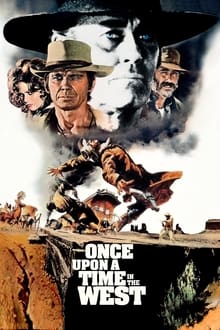
One of the great western movies.
Western movies made in co-production by Italians and Americans (called "spaghetti-western") have been considered among the best that emerged within their genre, cleverly combining the tough action of Wild West gunslingers with the taste for raw realism and detail of the Italian filmmakers. I believe that such a thing may displease North Americans, who consider the cowboy a figure that is "true USA". I therefore invite them to visit the Brazilian city of Barretos, or the rural areas of Goiás, Mato Grosso or Tocantins in Brazil. There are plenty of cowboys there… they just lack the guns.
Sergio Leone is an unavoidable figure here, having been responsible for the greatest “spaghetti” ever made. In this film, he gives us again a remarkable job, full of qualities. I don't consider it the best of his career or the best "spaghetti western" ever made, but it definitely has a place on the podium. The film begins very well, with the massacre of an Irish immigrant and his family, which leaves in the hands of a second wife – yes, the man was secretly a bigamist – a few acres of uninteresting desert... but there are people willing to kill for it. It happens that the smart Irishman had bought the only viable land for the railroad, and had even acquired the right to build a station and a new settlement! In the middle, we still have a gunslinger in search of personal revenge and another, in the pay of the railroad itself.
Let's face things frankly: the movie is good. It's a classic in its own right, almost mandatory for any movie lover, which doesn't mean that it's mandatory to like it! It is not a perfect film, it has problems that we will talk about, but it is equally endowed with characteristics and qualities that deserve to be valued.
The cinematography is very elegant, with good light and color. The sets and costumes are beautiful, even if it is frankly difficult to set a date to the film. In addition to the fact that the script does not establish a rigorous chronology, it's clear that the concern of the production designer and costume designers was aesthetics rather than historical rigor because there is a mixture of props, clothing and objects from the 1870s, 1880s and 1860. Is it a minor problem? Yes, but it is still a problem and a sign of the carelessness with which many productions are still facing historical rigor nowadays. The visual and special effects are put to good use and the soundtrack, atmospheric and truly impactful, is one of Ennio Morricone's most powerful works. Unfortunately, the film's editing was not the best, with cuts so abrupt and violent that it almost leads one to believe that the film was cut "a posteriori" for some reason. And perhaps the biggest problem turns out to be its excessively slow and annoying construction, with each scene lasting three minutes longer than necessary and the general length reaching three hours unnecessarily.
We can only say good things about the cast: among a vast succession of unknown and unimportant Italians, there are some outstanding actors who do not disappoint us and give us magnificent interpretations. Charles Bronson is a good-hearted tough guy with a monstrous charisma that steals our attention whenever he appears. Henry Fonda is effective as a villain, showing the actor's enormous versatility. Claudia Cardinale, one of the muses of cinema at the time, combines an impressive resilience of spirit, a high dose of charisma and a beauty that is still remembered today. Jason Robards has the difficult task of being the helpful good guy who ends badly to glorify the hero, but he takes the opportunity to show all his value as an actor.